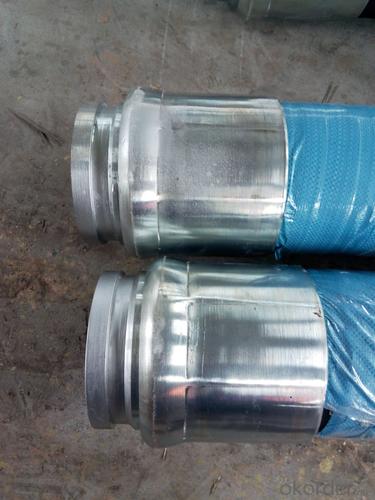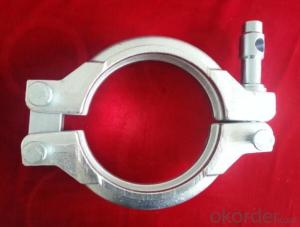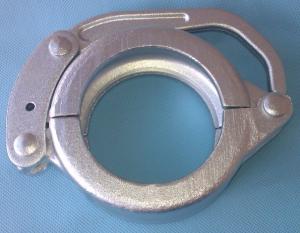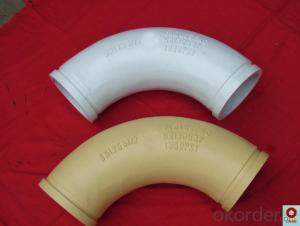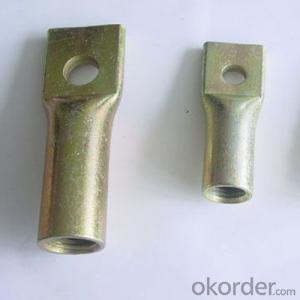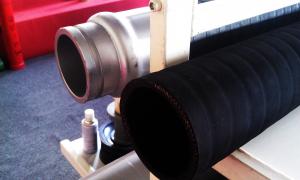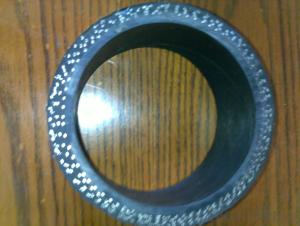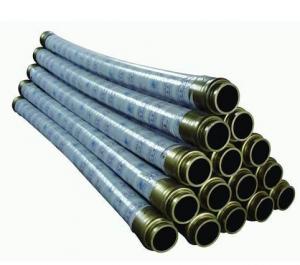Concrete Pump Rubber End Hose with Galvanizing Flange
- Loading Port:
- Shanghai
- Payment Terms:
- TT OR LC
- Min Order Qty:
- 1 PCS
- Supply Capability:
- 1000 PCS/month
OKorder Service Pledge
OKorder Financial Service
You Might Also Like
Product Description:
1. Specification
Concrete Pump Rubber End Hose with Galvanizing Flange1.Size:5 inch
2.Steel hose
3.2 or 4 piles of steel wires for your choose.
Name | Concrete rubber hose; Delivery hose; End hose; Concrete pump hose; Boom hose |
Size | 2"/2.5"/3"/3.5"/4"/4.5"/5"/6"or according to client’s requirement |
Length | 3M,5 or Any length |
Reinforcement | Steel wire, tire cord or fabric |
Hose End | Galvanized, inner wall harden |
Application | Schwing, Putzmeister, Sany, Zoomlion, etc |
2. Application
1.Applacation:delivery concrete
2.Suitable for the various :Schwing, CIFA,PM, Zoomlion ,SANY and so on.
3. Package
Put into containers.
FAQ:
Q1: Why buy Materials & Equipment from OKorder.com?
A1: All products have its ISO certifications, adheres to the highest standards and a commitment to supply chain safety and customer satisfaction.
Q2: How do we guarantee the quality of our products?
A2: We have established an advanced quality management system which conducts strict quality tests at every step, from raw materials to the final product. At the same time, we provide extensive follow-up service assurances as required.
Q3: How soon can we receive the product after purchase?
A3: Within three days of placing an order, we will begin production. The specific shipping date is dependent upon international and government factors, but is typically 10 to 30 workdays.
Q4: If we can produce Concrete Pump Rubber End Hose with Galvanizing Flange according to customers request?
A4: Yes, we can produce ConConcrete Pump Rubber End Hose with Galvanizing Flange according to the difference country situations to make it suitable to the market and customers. We have very professional technical team to make the design.
Q5: How to make a quick resolution for after service?
A5: We have overseas branches all-around of world, If needed, the seller shall dispatch 2 engineers to the buyer's site for supervision of training. The buyer shall make available of necessary facilities &skilled personnel at site for training.
Image:

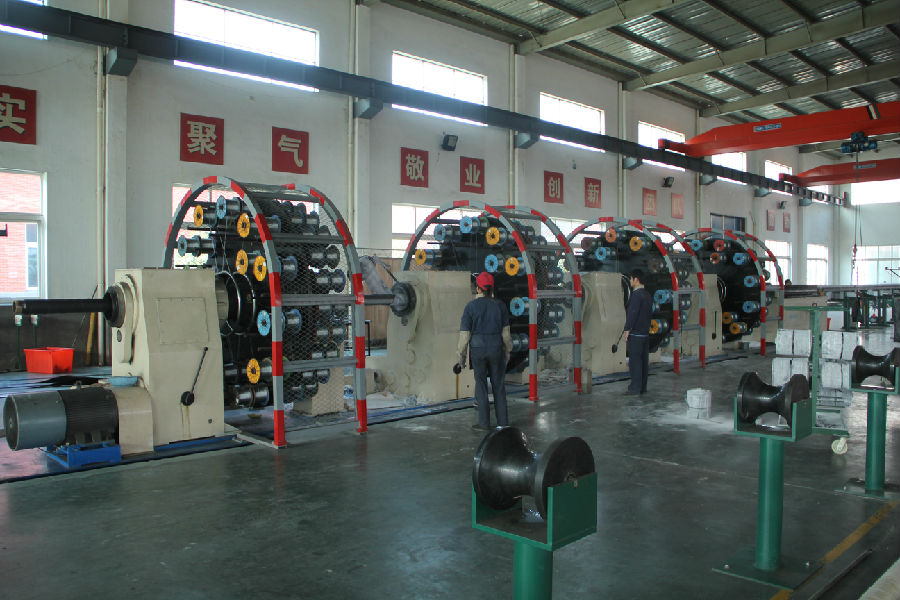
- Q: How often should concrete pump agitator motors be inspected and replaced?
- Regular inspections should be carried out on concrete pump agitator motors to ensure proper functioning and identify potential problems before they escalate. The frequency of inspections depends on factors such as workload and operating conditions. However, a general rule of thumb is to inspect the motors at least once per year or after every 500 hours of operation, whichever comes first. Monitoring the performance of the motors is crucial when considering replacement. If there are any indications of motor failure, such as overheating, excessive noise, or reduced efficiency, it may be necessary to replace the motor sooner rather than later. Additionally, if the motor fails any inspections or tests, immediate replacement is necessary to prevent safety hazards or disruptions in the concrete pumping process. Ultimately, prioritizing regular inspections and maintenance is key to prolonging the lifespan of the agitator motors and ensuring optimal operation. Following manufacturer guidelines, seeking advice from experts, and conducting routine checks will help determine the appropriate timing for inspections and replacements.
- Q: Are there any specific brands or manufacturers that are recommended for concrete pump spare parts?
- Yes, there are several brands and manufacturers that are recommended for concrete pump spare parts. Some of the most reputable ones include Schwing, Putzmeister, Sany, and Zoomlion. These brands have a proven track record for producing high-quality and durable spare parts that are compatible with various concrete pump models. It is always advised to consult with professionals or experts in the industry to determine the most suitable brand or manufacturer for specific concrete pump spare parts.
- Q: How does a hydraulic accumulator improve the performance of a concrete pump?
- To ensure a constant and reliable flow of concrete, a hydraulic accumulator is employed to enhance the performance of a concrete pump. The primary role of this hydraulic device is to store hydraulic energy in the form of pressurized fluid. In the case of a concrete pump, it stores and releases energy from the hydraulic system as needed during the pumping process. Efficiency and productivity in concrete pumping rely on a consistent flow of concrete. However, variations in demand or pressure fluctuations can pose challenges. This is where the hydraulic accumulator comes into play. By storing surplus hydraulic energy, the accumulator acts as a buffer, smoothing out any irregularities in the hydraulic system. When additional power is required, the stored energy is released, providing a boost to the hydraulic system. This ensures a continuous and steady flow of concrete, even during periods of high demand or pressure changes. Furthermore, hydraulic accumulators also contribute to reducing wear and tear on the pump components. By absorbing and dampening pressure shocks, they prevent sudden spikes and fluctuations from reaching the pump. This helps to extend the pump's lifespan and minimize the risk of breakdowns or damage. Overall, a hydraulic accumulator plays a critical role in enhancing the performance of a concrete pump. It ensures a steady flow of concrete, reduces pressure fluctuations, and protects the pump from excessive wear and tear. This results in improved efficiency, reliability, and durability of the pump, ultimately leading to increased productivity and cost savings in concrete pumping operations.
- Q: How does a hopper agitator motor ensure consistent concrete mixing?
- Consistent concrete mixing is guaranteed with the use of a hopper agitator motor, which is responsible for providing the required agitation and movement within the hopper. By rotating and moving the agitator blades, the motor effectively mixes the concrete ingredients. The main purpose of the hopper agitator motor is to avoid the settling or separation of the concrete during the mixing process. Through its rotation, a swirling motion is generated inside the hopper, ensuring even distribution and thorough blending of all the ingredients. This prevents any formation of clumps or irregularities in the final concrete mixture. Moreover, the motor also aids in breaking up any lumps or clusters that may have formed within the hopper. This action further enhances the uniformity of the mixture, ensuring proper blending of components such as cement, aggregates, water, and additives. Furthermore, the continuous movement of the agitator blades helps in maintaining the desired consistency and homogeneity of the concrete mix. It prevents heavier particles from settling at the bottom of the hopper, ensuring consistent mixture throughout the entire mixing process. In conclusion, the hopper agitator motor is of utmost importance in achieving consistent concrete mixing. Its role includes providing necessary agitation, preventing segregation, breaking up lumps, and maintaining uniformity. The motor's rotational motion and well-designed agitator blades contribute to well-mixed and homogeneous concrete, which is crucial for durable and high-quality concrete structures.
- Q: What is the purpose of a concrete pump agitator motor?
- The purpose of a concrete pump agitator motor is to ensure the consistency and quality of the concrete mixture being pumped. It is responsible for keeping the concrete mixture well-mixed and preventing it from settling or separating during the pumping process. The agitator motor helps to maintain a uniform and homogenous mixture, which is crucial for achieving strong and durable concrete structures. By continuously agitating the concrete inside the pump, the motor helps to prevent any blockages or clogs that could potentially disrupt the pumping operation. Overall, the purpose of a concrete pump agitator motor is to enhance the efficiency and effectiveness of the concrete pumping process, ultimately resulting in better construction outcomes.
- Q: What are the common signs of wear and tear on concrete pump spare parts?
- The common signs of wear and tear on concrete pump spare parts can vary depending on the specific part in question. However, there are some general signs that can indicate when a concrete pump spare part is experiencing wear and tear. One common sign is visible damage or deterioration on the surface of the part. This can include cracks, chips, or dents on the outer layer of the spare part. These damages can occur due to regular use, exposure to harsh environmental conditions, or accidental impact during operation. Another sign is increased vibration or noise during operation. If a concrete pump spare part is experiencing wear and tear, it may start to produce unusual vibrations or noises that were not present when it was in good condition. This can be an indicator of internal damage or misalignment of the part, which can affect its overall performance and efficiency. Reduced performance or efficiency is also a common sign of wear and tear on concrete pump spare parts. If a part is experiencing wear and tear, it may not function as effectively as before, resulting in decreased pumping capacity, reduced flow rate, or inefficient operation. This can lead to delays in construction projects and increased maintenance costs. Additionally, increased maintenance and repair requirements can indicate wear and tear on concrete pump spare parts. If a part needs to be repaired or replaced more frequently than usual, it could be a sign that it is experiencing wear and tear. Regular inspections and maintenance can help identify potential issues early on and prevent further damage to the spare parts. In conclusion, signs of wear and tear on concrete pump spare parts can include visible damage, increased vibration or noise during operation, reduced performance or efficiency, and increased maintenance requirements. It is important to regularly inspect and maintain these spare parts to ensure their optimal performance and prolong their lifespan.
- Q: How does a concrete pump S valve function?
- A concrete pump S valve functions by controlling the flow of concrete from the hopper to the delivery pipeline. It consists of two flat plates attached to a shaft that can rotate. When the S valve is in the closed position, the plates are pressed together to prevent the concrete from flowing through. As the shaft rotates, the plates separate, allowing the concrete to pass through and be pumped to the desired location. This mechanism ensures efficient and precise control of concrete flow during pumping operations.
- Q: What is the role of a concrete pump hopper grate spring?
- The role of a concrete pump hopper grate spring is to provide tension and support to the hopper grate, ensuring that it remains securely in place while allowing for smooth and consistent flow of concrete through the pump.
- Q: How can a damaged concrete pump piston affect the pumping efficiency?
- The pumping efficiency can be significantly affected in various ways by a piston that is damaged. To begin with, reduced pumping capacity can result from decreased power and force exerted by the pump due to a damaged piston. The piston's responsibility is to generate the necessary pressure for pushing the concrete mixture through the pumping system. If it is damaged, it may fail to generate adequate pressure, leading to slower and less efficient pumping. In addition, leaks can occur within the pump system due to a damaged piston. The piston plays a critical role in sealing the concrete and preventing it from leaking back into the hopper. If it is damaged or worn out, a tight seal may not be created, resulting in leakage. This not only leads to material loss but also reduces pumping efficiency as the pump has to compensate for the loss by working harder. Moreover, blockages and clogs can be caused by a damaged piston in the pumping system. The movement of the piston creates suction, which pulls the concrete mixture into the pump. If the piston is damaged, it may not create sufficient suction, causing the mixture to flow unevenly or get stuck in the system. This can cause delays and interruptions in the pumping process, ultimately reducing overall efficiency. In conclusion, the pumping efficiency can be negatively impacted by a damaged concrete pump piston through reduced power and force, leaks, and blockages. It is crucial to regularly maintain and promptly repair or replace damaged pistons to ensure optimal pumping performance and efficiency.
- Q: What are the safety measures to consider while replacing concrete pump spare parts?
- When replacing concrete pump spare parts, there are several important safety measures to consider. Firstly, it is crucial to ensure that the pump is turned off and all power sources are disconnected before beginning any work. Additionally, wearing appropriate personal protective equipment, such as gloves, safety glasses, and steel-toed boots, is essential to protect against potential hazards. It is important to follow the manufacturer's guidelines and instructions for replacing the specific spare part to ensure proper installation and prevent accidents. Lastly, maintaining a clean and organized work area, free from clutter and debris, can help prevent trips and falls while working on the pump.
Send your message to us
Concrete Pump Rubber End Hose with Galvanizing Flange
- Loading Port:
- Shanghai
- Payment Terms:
- TT OR LC
- Min Order Qty:
- 1 PCS
- Supply Capability:
- 1000 PCS/month
OKorder Service Pledge
OKorder Financial Service
Similar products
Hot products
Hot Searches
Related keywords



